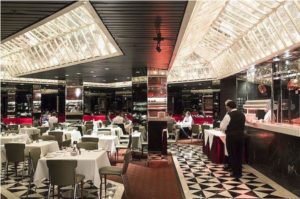Some speakers testified that landmarked space should be expanded to connect bar and lobby as one designated interior. At its meeting on November 22, 2016, the Landmarks Preservation Commission heard testimony on the potential designation of two interior spaces on the first floor of the United Nations Hotel at 1 United Nations Plaza in East Midtown. The interiors under consideration are the Ambassador Grill and the Hotel Lobby, built as part of a hotel and office complex by the United Nations Development Corporation. Both designed by the firm Kevin Roche Dinkeloo Associates. The grill was completed in 1976, and the Lobby in 1983. Landmarks voted to add the interiors to its calendar on September 20, 2016.
The U-shaped Grill features mirrored walls and a vaulted faux skylight, lit by illuminated backing panels. The Lobby possesses a stepped octagonal glass dome, free-standing columns flanking a ramped hallway, and a patterned black and white marble floor. Landmarks Research Department said the stylistic vocabularies of the two spaces represented the shift from Late Modern to Early Postmodern design in the 1970s and 1980s. Kevin Roche, who won the Pritzker Prize in 1982, and John Dinkeloo, were both protégés of Eero Saarinen, and their other work includes the nearby individual and interior landmark the Ford Foundation.
Docomomo chapter president John Arbuckle said Roche was one of the most significant architects of the late 20th century, and that the Grill was a rare example of a publicly accessible late-Modern interior. Kyle Johnson, also of Docomomo, noted that it was rare for a hotel exterior and interior to be designed by the same architect, providing a unique consistency through the outside and inside. Society for the Architecture of the City representative Christabel Gough spoke of the importance of preserving diverse examples of the “ideological controversies” surrounding architectural design in the 20th century, and urged Landmarks to preserve the experience of “a dazzling 1970s New York nightclub” for future generations. One speaker read a letter from Robert A.M. Stern, former Dean of the Yale School of Architecture, in which he called the interiors “masterworks of Modernism,” and said they merited regard on par with Vienna’s Karntner Bar, designed by Adolf Loos, and Sir John Sloane’s Museum in London.
The Historic District Council’s Barbara Zay lobbied the Commission to include the sitting area portion of the lobby in the designation, saying it retained many of the same special features, and to exclude it would be “tantamount to designating a half of the same space.” Current Kevin Roche John Dinkeloo Associates Principal Wesley Kavanagh testified that Roche and the firm endorsed designation. Kavanagh expressed concern about the division of the two distinct areas under consideration for landmarking, saying “this is one architectural space and should be designated as such,” and urged Landmarks to include the connecting spaces between the Lobby and Grill in any designation.
Landmarks Executive Director Sarah Carroll stated that Commission staff had extensively surveyed the hotel’s interiors and identified the “strongest, most distinctive spaces” for possible designation. Carroll said the sitting area identified by HDC was separated from the rest of the lobby by pillars and grade change, possessed fewer significant features, and didn’t connect to the spaces in the same way as the areas proposed.
Chair Meenakshi Srinivasan closed the hearing, and said further study would be conducted in light of public testimony. Srinivasan did not set a date for a vote on designation
LPC: United Nations Hotel, First Floor Interiors, 1 and 2 United Nations Plaza, Manhattan (LP-2588) (Nov. 22, 2016).
By: Jesse Denno (Jesse is a full-time staff writer at the Center for NYC Law).


